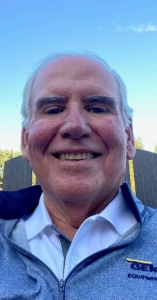OUR Art of the Possible #MondayBlogs

Today, our founder and managing member, Ron Slee, takes a broad look at what we do and how we do it in, “OUR Art of the Possible,” a blog post for #MondayBlogs.
We have been busy around here for quite a time now. I am sure it is much the same for most of you. I have been struggling somewhat in trying to put balance in my life. Ideally, we all have some sense of balance within our careers, our families and ourselves. In most cases the first thing we drop is looking after ourselves. Next, we concentrate on keeping our career, so we become consumed at times with work. That is not a good “art of the possible.”
When I left the employment of dealers and went out on my own in 1980 it was a rather meaningful change in my approach to what I wanted to do with my life. I had been married for six years and had a wonderful daughter. We had moved from Quebec because of the political dynamic there and moved across the country to British Columbia. That was quite a change and quite a move. From that initial move we have lived in Denver, Palm Desert and Hawaii.
The first time we were in Hawaii I commented on the fact that I felt completely decompressed when I got off the airplane. We have wanted to live in Hawaii ever since. We had been planning this for what seems like forever and have finally done it. As of December 29, 2016, we became residents of Hawaii.
That is the positive side of things and of course there is a negative side as well. The Ying and Yang of life continues. Our daughter Caroline, her spouse Joanna, and our grandchildren are still in California. Not being able to see them on impulse is not so much fun. We miss them and their growing up and life experiences and their energy. We must adjust our approaches as a family when we are together and really take advantage of every minute, we are able to be together.
Another thing that happened is that I have completely stopped soliciting consulting work. I have clients, to be sure, that continue to want to collaborate with me in their businesses. I am blessed with wonderful clients. We started the consulting business in June 1980 in Edmonton, Alberta, Canada not too far from where I was born in Mannville, Alberta.
I am not sure, but I think winding down the business has been more traumatic for me than starting it in the first place. One was challenging work the other was emotional work. You have an identity as a worker that to some degree defines who you are in life. When you stop doing the work you have the potential to lose who you are. I am sure someone could say that much more eloquently than I, perhaps Caroline.
I have been presented wonderful opportunities along the way. Several mentors helped me. David Steele, a consultant with Urwick Curry who taught me how to evaluate business systems. From Bob Kirk and Larry Noe and Roger Fay at Caterpillar Tractor, who put me under their wings. From Rod Boileau, the individual for whom I have unlimited respect. I have truly been lucky with the individuals helping me with my personal development.
It seems that I have always been curious and wondering “why” we did things certain ways. The consulting world is the perfect place for me to have ended up. I have also always been teaching in my life. Starting as a teenager at a Country Club in the summers. Then to be teaching at McGill University. Even in my consulting work I was instructing people about new methods or systems.
In the early 1990’s most manufacturers and associations stopped doing management training. It had become too expensive. Employee Development had become a “discretionary expense.” Well, I disagreed with that and decided that we would get back into teaching. This time in management training. It was 1992 and I sat in my office talking to the computer and created three two-hundred-and-fifty-page training manuals; parts, service as well as selling and marketing.
I sat talking to my computer using voice recognition. IBM had a product called ViaVoice and this was clearly the early days for that technology. I would talk for an hour and then the computer would work for two hours putting it all in a word document. This was the start of our employee development business. We called it Quest, Learning Centers. We incorporated it in Colorado. From there I asked my consulting clients if they would be willing to come and critique the different classes by sitting in for three days and experiencing what I would be teaching. They provided invaluable assistance. We changed a lot about how we were structured and ended up with two-day classes. We offered fifteen hours of learning with each two-day class. That gave us a nice structure for teaching. Four blocks of learning which we split into two specific learning experiences, two hours each. We covered Leadership, Operations, Selling, and Finance. Those two-hour subject specific class segments are with us still today. Quest, Learning Centers became the sole supplier of management training for the Associated Equipment Distributors in 1994 and we continued until 2015 when we chose to take a different direction in delivering our training products.
In the early 2000’s webinars became the new training method. No travel, short sessions and inexpensive was the goal. We created many webinars. Each of them was about an hour of learning. It was slides that everyone could see with me talking to them expanding what was on the slides. I hated it. I am a teacher at heart, and I couldn’t see the students. So, I changed things up and got a high-definition camera and projector and ran the webinars with remote control. This allows me to break the learning into “chunks” of about ten minutes. I would then turn off the slide show, walk in front of the camera, and talk to the audience. They could see me, which helped but I still couldn’t see them. I started to wear Hawaii Shirts, almost like a uniform and people became rather interested in what shirt I was going to be wearing during the webinars.
So, we offered three levels of classroom training with Quest; What It Looks Like When it is Right, Performance Excellence, Reaching Market Potential. We need this for the Parts business, the Service business, the Selling business and Parts and Service Marketing business. We offered over twenty different webinars. I started looking at how we could change our offering and make it more available to more people.
By the year 2000 I was doing training for Komatsu, Volvo, Ditch Witch dealers worldwide. I was conducting training for Caterpillar, Deere, and Bobcat dealers in North America. I was also doing dealer specific training for large dealers across the world. It was a lot of travel and incredibly challenging physically with time zones and being away from home. I started to explore different options for a delivery system.
I have always been involved with technology. Another individual who was very influential in my work life was Ian Sharp. He founded IP Sharp Associates which provided internet-based business systems in the early 1970’s. I was using the internet in 1973 with a “portable” computer. That is a rather interesting description of a “electric” typewrite as the terminal and an acoustic coupler to connect to my telephone. Now don’t laugh, the network speed was 30 BPS. Imagine that? Well, there were very few people on the network, so it was fine.
My first consulting work was with Canadian National Railways, officially sanctioned by my employer at the time, Hewitt Equipment. I designed warehouses using the computer. I got dimensions, usage activity and inventory levels and built virtual warehouses. The system placed every part number in the appropriate location based on size and activity and inventory levels. Created a move list of parts in the old locations and where they were to be placed in the new locations. We also designed the picking and packing and shipping functions and determined the number of people necessary to be employed to satisfy the needs of the users. It was a lot of fun and extremely challenging. I did that type of work with a lot of dealers. That was something that really excited me.
So, I had always had my eye on being able to work independently and Marlene, my wife, and I talked about it often. We did that in 1980 when I started consulting and now, I was looking at the next Possibility and that was taking our training products to the internet.
We created Learning Without Scars in 2015. Well, it is now a Hawaii Corporation, and the California business was closed as of December 2016. But there was a lot of work to do converting everything that we did to the internet.
Caroline was doing the yeoman’s work in converting all our learning products to an internet-based Learning Management System, we now use Litmos and getting all this material fresh copyrights and trademarks. Our training business started with Quest, Learning Centers. We started with Classroom courses with three levels and four modules per level. These management training programs were created in the early 1990’s. We took that material and compressed it into Webinars starting in the early 2000’s. With the internet option, we had to convert these webinars, of which we had developed over ninety different programs, to the Learning Management Software Litmos. This meant a heavy learning curve for Caroline and a lot of work for me. Everything had to be redone. The text content all had to be updated and upgraded. Then we needed to create audio files to go with the text. Then we had to run prototypes so we could have input from actual learners. They wanted to inject me into the program like we had in the webinars so we are working with a Professional, Paul Baumann, from XFINIGEN Media, and creating Vimeo files which we will insert into the learning products.
And finally, Caroline is working with the IACET, The International Association of Continuous Education Training and we are now an Approved Provider of educational products. All our learning programs certified so that they will earn CEU’s, Continuous Education Units credits that would apply to Colleges, Universities and Junior Colleges across the world. That, too, is a big task but one that will bring us, we believe, nice results. We have been and continue to be busy. We keep changing things.
I don’t know how many of you know that my mother was a teacher, a well-recognized teacher in her day as one of the pioneer teachers of the Pittman reading program, which accelerated the ability of young children to read. Kindergarten and Grade one specifically was reading newspapers and comprehending. My grandmother was a teacher. She received her master’s degree from the University of Manitoba in 1915. Granny taught in a one room schoolhouse, and I had the pleasure of meeting several of her students when they attended her eightieth birthday party. I suspect she had an impact on them, don’t you? My daughter Caroline is a teacher. She teaches in the California School System. We must have some teaching chops in the genes. I know I get excited when I see the lights go on in peoples’ eyes when they “GET” something.
But one thing I can tell you is that Learning is HARD. I know we have been told how to learn repeatedly. It is repetition. Do it repeatedly ad nausea. That never really worked for me so that is not how I taught. I wanted people to understand something so that they would remember it. Not memorize it so they could forget it.
It turns out that the instructions from schools and teachers about – highlighting and underlining and sustained reading and rereading notes and texts are not that appropriate. Endel Tulving, a psychologist, at the University of Toronto challenged this traditional model of learning and remembering through his series of investigations starting in the mid-1960’s. Tulving found that the learning curves were statistically indistinguishable between the tried-and-true learning pattern recommended above and random learning models that were not based on repetition. Well, that is how we have designed the internet learning programs. We want you to Learn, to Know, not to memorize.
I am excited about what we are doing, and we are busy releasing innovative programs every month. We have one hundred and eight different subject specific classes and eighteen comprehensive skills assessments.
We have help from Ross Atkinson who has a deep background in IT. He is keeping us on the leading edge of technology. We use software to create audio tracks from word documents. We use software to create closed captions on all our film clips and Podcasts. We are currently testing software which will emulate our teacher with a Customer Character who will deliver instructions in eight or less minutes using an emulation of the teacher’s voice. And we will be able to do this in multiple languages. We are trying to provide the latest technology with the latest in educational deliveries.
We have developed two distinct learning programs. One which is for Technical Schools, students, and the other for Workforce Development, adult learning. We are being helped in this arena by Steve Johnson. Steve has been retired for a few years now and has agreed to help us getting our products into schools across the US and Canada.
Based on what Steve and the schools have concluded each of our classes for the Technical Schools has to cover thirteen hours of face-to-face training and twenty six hours of homework. Our classes consisted of slides with text, audio tracks and film clips. We had to go back to the drawing board once again and redevelop our classes. Each Class for the Technical Schools now has six and a half hours of face-to-face learning and thirteen hours of homework. Two of our classes now qualify as academic credits for technical schools. We also modified our adult education. The conclusion of our students who are full-time employed was that those classes were too long. So, we developed a separate series of learning products for adult education that are five to six hours of learning split up into one-hour chapters. These classes typically are completed in a one-month period.
Well, that is our journey on “OUR Art of the Possible.” What is yours?
The time is now.
Did you enjoy this blog? Read more great blog posts here.
For our course lists, please click here.





